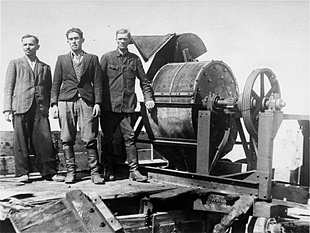Sonderkommandos
| Sonderkommando | |
|---|---|

Jewish work-detail next to a bone crushing machine
|
|
| Location | German-occupied Europe |
| Date | 1942–1945 |
| Incident type | Removal of Holocaust evidence |
| Perpetrators | Schutzstaffel (SS) |
| Participants | Arbeitsjuden |
| Camp | Extermination camps including Auschwitz, Belzec, Chełmno, Majdanek, Sobibór and Treblinka among others |
| Survivors | Zalman Gradowski, Filip Müller, Henryk Tauber, Leib Langfus, Morris Venezia, Henryk Mandelbaum, Dario Gabbai |
Sonderkommandos were work units made up of German Nazi death camp prisoners. They were composed of prisoners, usually Jews, who were forced, on threat of their own deaths, to aid with the disposal of gas chamber victims during the Holocaust. The death-camp Sonderkommandos, who were always inmates, should not be confused with the SS-Sonderkommandos which were ad hoc units formed from various SS offices between 1938 and 1945.
The term itself in German means "special unit", and was part of the vague and euphemistic language which the Nazis used to refer to aspects of the Final Solution (cf. Einsatzkommando units of the Einsatzgruppen death squads).
Sonderkommando members did not participate directly in killing; that responsibility was reserved for the guards, while the Sonderkommandos' primary responsibility was disposing of the corpses. In most cases they were inducted immediately upon arrival at the camp and forced into the position under threat of death. They were not given any advance notice of the tasks they would have to perform. To their horror, sometimes the Sonderkommando inductees would discover members of their own family amid the bodies. They had no way to refuse or resign other than by committing suicide. In some places and environments, the Sonderkommandos might be euphemistically connoted as Arbeitsjuden (Jews for work). Other times, Sonderkommandos were called Hilflinge (helpers). At Birkenau the Sonderkommandos or "special squads" reached up to 400 people by 1943, and when Hungarian Jews were deported there in 1944, their number swelled to over 900 persons to accommodate the increased rounds of murder and extermination.
Because the Germans needed the Sonderkommandos to remain physically able, they were granted much less squalid living conditions than other inmates: they slept in their own barracks and were allowed to keep and use various goods such as food, medicines and cigarettes brought into camp by those who were sent to the gas chambers. Unlike ordinary inmates, they were not normally subject to arbitrary, random killing by guards. Their livelihood and utility was determined by how efficiently they could keep the Nazi death factory running. As a result, Sonderkommando members tended to survive longer than other inmates of the death camps — but few survived the war.
...
Wikipedia
